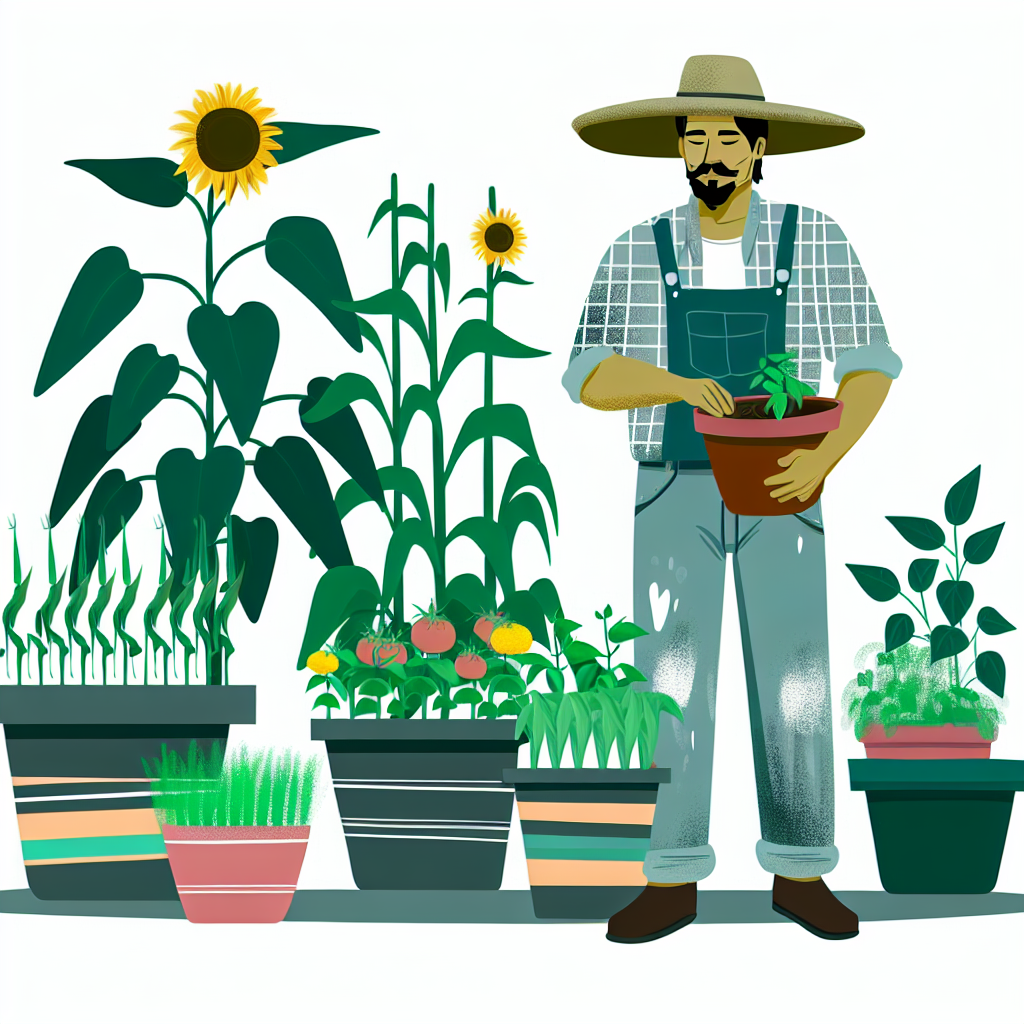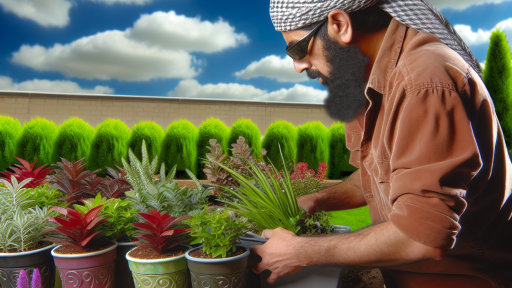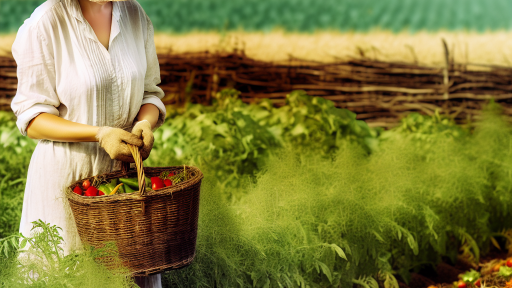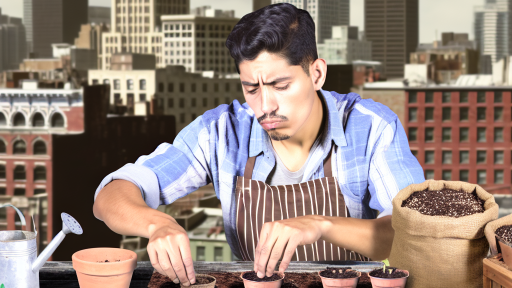Introduction to Companion Planting
Benefits of Companion Planting
Companion planting enhances the growth of plants in container gardens.
This method promotes natural pest control and increases yield.
Additionally, it offers improved nutrient uptake for plants.
Moreover, certain plants can enhance flavor and aroma when grown together.
Basics of Companion Planting
Understanding the basics of companion planting is essential for success.
Different species of plants can have mutually beneficial relationships.
For instance, some plants can deter pests that plague others.
Others may provide shade or support for climbing vines.
This strategy requires careful planning and knowledge of plant compatibility.
Choosing Your Container Plants
Selecting the right plants for containers adds to the success of companion planting.
Consider varieties that grow well together and share similar needs.
For instance, pairing basil with tomatoes can enhance their growth.
Moreover, marigolds can deter harmful insects when grown alongside vegetables.
Research and experimentation play crucial roles in identifying successful combinations.
Practical Tips for Implementation
Begin by designing a layout that maximizes space and light.
Transform Your Agribusiness
Unlock your farm's potential with expert advice tailored to your needs. Get actionable steps that drive real results.
Get StartedArrange plants in such a way that taller varieties do not overshadow shorter ones.
Additionally, consider the growth habits of each plant during planning.
Regularly monitor plant health and growth for adjustments if necessary.
Finally, document your findings for future planting seasons.
Selecting the Right Containers for Companion Planting
Understanding Container Choices
Choosing the right container is vital for successful companion planting.
Consider the type of plants you want to grow together.
Some plants thrive in small pots, while others need larger spaces.
Furthermore, the materials of the container play a significant role.
Material Options
Different materials have different properties and benefits.
Terracotta containers offer excellent drainage for many plants.
Plastic pots are lightweight and come in varied designs.
Additionally, wooden containers provide good insulation for roots.
Size Matters
Selecting the right size container is essential.
Small containers work well for herbs and compact plants.
Larger plants need bigger containers to support their growth.
Keep in mind the mature size of the plants when selecting containers.
Drainage Considerations
Proper drainage is crucial to prevent water stagnation.
Ensure containers have drainage holes at the bottom.
You can also add materials like gravel for better drainage.
Moreover, consider using self-watering containers for consistency.
Companion Planting Combinations
Choosing compatible plant combinations enhances growth.
For example, tomatoes and basil grow well together.
Additionally, marigolds deter harmful pests when placed with vegetables.
Research specific pairings to maximize benefits.
Showcase Your Farming Business
Publish your professional farming services profile on our blog for a one-time fee of $200 and reach a dedicated audience of farmers and agribusiness owners.
Publish Your ProfileAesthetic Appeal
Select containers that complement your space.
Color and design can add beauty to your garden.
Combine different shapes and sizes for a more dynamic look.
Above all, ensure the aesthetics do not compromise plant health.
Best Companion Plants for Vegetables in Containers
Benefits of Companion Planting
Companion planting enhances growth, flavor, and pest control in container gardens.
This strategy maximizes available space and resources in your containers.
Furthermore, it can lead to healthier plants and higher yields.
Choosing Companion Plants
Select companion plants that support each other’s growth.
Look for plants that attract beneficial insects or deter pests.
For instance, some herbs can repel harmful insects from vegetables.
Selecting diverse plants can improve the overall resilience of your garden.
Examples of Effective Pairings
Several combinations work well in container gardens.
Try planting basil alongside tomatoes for a flavor boost.
Basil improves the growth of tomatoes while repelling pests.
Additionally, marigolds planted with vegetables deter nematodes effectively.
Herbs as Companion Plants
Herbs can serve multiple purposes in your container garden.
For instance, cilantro grows well with tomatoes and peppers.
Its scent can confuse pests, keeping your vegetables safe.
Moreover, dill attracts beneficial insects that help pollinate nearby plants.
Flowers to Enhance Growth
Including flowers can attract pollinators and beneficial insects.
Nasturtiums are attractive and can deter aphids from nearby plants.
This combination benefits both aesthetics and plant health.
Understanding Plant Compatibility
Some vegetables thrive better together than others.
Onions and carrots are a classic pairing that benefits both.
Onions repel pests that commonly harm carrots.
Making informed choices helps ensure successful companionship.
Pest Management through Companion Planting
Effective companion planting helps reduce pest invasions.
Certain plants can act as traps, luring pests away from vegetables.
For example, plant radishes to distract flea beetles from more valuable crops.
Implementing Your Companion Planting Strategy
Begin by researching suitable companion plants for your specific vegetables.
Plan your container layout to maximize space and benefits.
Regular observation will allow you to adapt your strategy over time.
Inspect for pest activity and plant health regularly for best results.
See Related Content: Essential Guide To Container Gardening For Farmers
Herbs and Flowers: Enhancing Container Gardens through Companion Planting
The Importance of Companion Planting
Companion planting brings harmony to container gardens.
This practice promotes healthy plant growth.
Additionally, it helps deter pests naturally.
By pairing certain plants, gardeners can boost yields.
Furthermore, this technique supports biodiversity.
Herbs as Companions
Herbs make excellent companions in container gardens.
Showcase Your Farming Business
Publish your professional farming services profile on our blog for a one-time fee of $200 and reach a dedicated audience of farmers and agribusiness owners.
Publish Your ProfileThey offer culinary benefits while supporting neighboring plants.
Basil thrives alongside tomatoes, enhancing flavor and growth.
Chives deter aphids, protecting roses nearby.
Moreover, mint can repel pests when planted with cabbage.
Flowers That Benefit Container Gardens
Flowers can enhance the beauty of container gardens.
The right flowers attract beneficial insects.
Marigolds are renowned for repelling nematodes and aphids.
Pansies bring color and can keep pests at bay.
Additionally, borage attracts pollinators and improves vegetable yields.
Plant Pairing for Optimal Growth
Choosing the right plant pairings is essential.
Certain herbs and flowers can enhance nutrient availability.
Nasturtiums are great companions for radishes, improving their growth.
Similarly, cilantro can thrive well alongside spinach.
Thus, understanding plant relationships increases success.
Container Garden Layout Tips
Strategically planning your container layout is crucial.
Group plants with similar needs together for better outcomes.
For example, place sun-loving herbs in one container.
Conversely, shade-loving plants belong in a different setup.
Ensure adequate spacing for air circulation and light.
Caring for Companion Plantings
Taking care of companion plants boosts their effectiveness.
Regularly check for pests and diseases.
Water each container appropriately based on plant needs.
Additionally, fertilize with organic options to support growth.
Observation is key to maintaining a thriving container garden.
Discover More: Companion Planting for Edible Landscapes
Understanding Plant Compatibility
Key Considerations for Companion Planting
Companion planting maximizes garden efficiency and health.
It involves pairing plants that benefit each other.
However, certain combinations can hinder growth.
Understanding these relationships is essential for success.
Avoiding Harmful Pairings
Some plants release chemicals that can harm neighbors.
For instance, tomatoes and potatoes should not be planted together.
They are both susceptible to similar pests and diseases.
Additionally, members of the onion family can stunt growth in beans.
Identifying Beneficial Companions
Conversely, certain plants thrive when grown together.
For example, basil enhances the flavor of tomatoes.
Moreover, marigolds can deter pests that attack vegetables.
Knowing which plants improve each other’s growth is crucial.
Testing Plant Compatibility
Conduct small trials to assess plant interactions.
Observe growth patterns and health of each variety.
Adjust pairings based on your observations and results.
Showcase Your Farming Business
Publish your professional farming services profile on our blog for a one-time fee of $200 and reach a dedicated audience of farmers and agribusiness owners.
Publish Your ProfileThis hands-on approach yields the best outcomes.
Research and Resources
Utilize books and online resources for guidance.
Numerous websites provide charts identifying compatible plants.
Connecting with local gardening groups can also be helpful.
Sharing experiences enhances your understanding of plant interactions.
Uncover the Details: Seasonal Seed Saving Guide For Farmers

Seasonal Companion Planting Strategies for Container Gardens
Spring Companion Planting
Spring marks an exciting time for planting.
During this season, choose companions that thrive in warmer weather.
For example, pairing tomatoes with basil enhances flavor and deters pests.
In addition, marigolds help repel nematodes and other harmful insects.
Consider adding lettuce or radishes as quick-growing companions.
Summer Companion Planting
As summer heats up, focus on plants that can tolerate the heat.
Cucumbers paired with sunflowers create great vertical growth and shade.
Borage is another excellent choice, attracting beneficial pollinators.
Be cautious of overcrowding; ensure adequate space for air circulation.
Fall Companion Planting
Fall container gardens thrive with cool-weather crops.
Planting kale alongside garlic improves growth and flavor.
Another effective combination is carrots with onions, which deter pests effectively.
Additionally, consider planting sage with a variety of fall herbs.
Winter Companion Planting
Even in winter, container gardens can remain productive.
Opt for hardy greens like spinach and arugula for cooler temperatures.
Pansies or violas can add beauty while surviving frost.
Grouping these plants together helps maximize space and warmth.
Overall Companion Planting Benefits
Companion planting offers multiple benefits to container gardens.
It enhances growth, flavor, and pest control effectively.
Additionally, diverse plantings contribute to soil health.
Lastly, the visual appeal creates a stunning display throughout the seasons.
Delve into the Subject: Scaling Your Mushroom Farm: Tips and Tricks
Pest Management through Companion Planting in Containers
Benefits of Companion Planting
Companion planting effectively reduces pests in container gardens.
It enhances both plant growth and yield.
Moreover, this strategy creates a natural ecosystem in small spaces.
Common Pairings for Pest Control
Certain plants naturally repel pests when grown together.
For instance, marigolds deter nematodes and attract beneficial insects.
Additionally, basil repels aphids and whiteflies when planted with tomatoes.
Consider planting garlic near roses to ward off aphids as well.
This strategy maximizes space and minimizes pest problems.
Specific Strategies for Container Gardens
When gardening in containers, strategic placement matters.
Place taller plants to provide shade for shorter companions.
For example, plant climbing beans next to basil or tomatoes.
Furthermore, interplanting serves to confuse pests and disrupt their lifecycle.
Showcase Your Farming Business
Publish your professional farming services profile on our blog for a one-time fee of $200 and reach a dedicated audience of farmers and agribusiness owners.
Publish Your ProfileA diverse planting scheme strengthens the garden against pests.
Selecting the Right Containers
The choice of container affects companion plant success.
Ensure containers are large enough to accommodate root systems.
Opt for pots with drainage holes to prevent excess moisture.
Moreover, use lightweight soil for easy handling and good drainage.
Monitoring and Adjusting
Regularly monitor for pest activity in your container garden.
Adjust plant pairings based on observed pest presence.
For instance, if aphids appear, increase basil or garlic companions.
Taking swift action maintains a healthy garden ecosystem.
Harvesting and Maintenance Tips for Companion Plants in Containers
Understanding the Importance of Harvesting
Harvesting is crucial for maximizing your container garden’s yield.
It encourages plants to produce more and enhances overall health.
Moreover, timing your harvest increases the flavor of the produce.
Identifying the Right Time to Harvest
Observe the size and color of your fruits and vegetables.
Most crops have specific signs of ripeness to look for.
For instance, tomatoes should be fully colored and slightly firm.
Beans should be plump, but not overly large to ensure tenderness.
Harvesting Techniques
Use sharp, clean scissors or garden shears for harvesting.
This prevents damage to the plant and reduces disease risk.
Harvest in the early morning for the best flavor and moisture content.
Maintaining Companion Plants
Regular maintenance ensures healthy growth and productivity.
Ensure each plant receives adequate sunlight and airflow.
Rotate containers periodically for even light exposure.
Watering Practices
Consistency in watering is key for container gardens.
Check moisture levels daily, especially during hot weather.
Avoid waterlogging, which can lead to root rot.
Consider using self-watering pots for added convenience.
Pest and Disease Management
Regularly inspect your plants for signs of pests and diseases.
Early detection allows for effective control measures.
Companion plants can serve as natural deterrents to pests.
Marigolds, for instance, repel aphids and nematodes.
Using Organic Fertilizers
Feeding companion plants with organic fertilizers promotes healthy growth.
Apply fertilizers during active growth phases for maximum effect.
Compost tea or fish emulsion provides vital nutrients.
Planning for Success
Plan your harvesting schedule based on plant maturity rates.
This ensures a steady supply of fresh produce through the season.
Additionally, record your planting and harvesting dates for reference.
Additional Resources
Registration is open for upcoming Purdue Small Farm Education …




